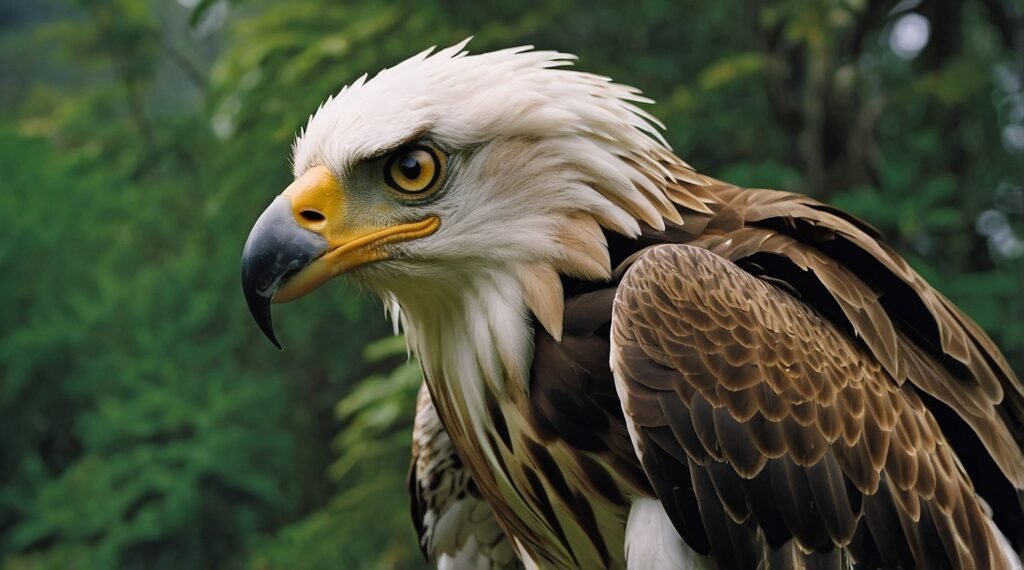Have you ever wondered what it would be like to witness one of the most awe-inspiring creatures on Earth? Imagine soaring through lush tropical forests, your keen eyes scanning the canopy below, powerful wings carrying you effortlessly through the air. This is the world of the Philippine Eagle, a majestic bird that has captured the hearts and imaginations of nature lovers, conservationists, and casual observers alike. As we embark on this journey to explore the life, habits, and challenges faced by this magnificent raptor, prepare to be amazed by its sheer beauty, impressed by its incredible adaptations, and moved by the urgent need to protect this endangered species.
The Regal Appearance: A Crown of Feathers
A Distinctive Look That Commands Attention
When it comes to appearances, the Philippine Eagle is truly in a league of its own. Picture a bird of prey with a wingspan that can stretch up to an impressive 7 feet – that’s wider than most humans are tall! But it’s not just the size that makes this eagle stand out. Its most striking feature is undoubtedly the crown of long, golden-brown feathers that adorn its head, giving it a regal and almost lion-like appearance. This unique characteristic is what earned it the nickname “Monkey-eating Eagle,” although we now know its diet is far more varied than that moniker suggests.
The eagle’s body is a canvas of contrasts, with dark brown feathers on its back and wings providing a stark contrast to the creamy white plumage of its underside and head. Its powerful beak, designed for tearing through tough prey, is a steely blue-gray, while its legs are a bright yellow, equipped with massive talons that can easily grip and carry off sizeable animals. Perhaps most captivating are its piercing blue-gray eyes, which seem to hold the wisdom of the ancient forests it calls home. This combination of features not only makes the Philippine Eagle one of the most beautiful birds in the world but also one of the most recognizable.
A National Treasure: Symbol of Philippine Pride
More Than Just a Bird: A Cultural Icon
It’s not every day that a bird becomes a national symbol, but the Philippine Eagle has earned this honor through its beauty, strength, and significance to the country’s biodiversity. In 1995, it was officially declared the national bird of the Philippines, replacing the Maya bird (Eurasian Tree Sparrow) that had held the title since 1936. This change was more than just a simple switch in mascots; it represented a growing awareness of the Philippines’ unique natural heritage and the need to protect it.
The eagle’s image can be found everywhere from coins and banknotes to government seals and tourist memorabilia. It has become a source of pride for Filipinos, embodying the spirit of freedom, strength, and uniqueness that the nation aspires to. Schools teach children about the eagle, fostering a sense of responsibility towards wildlife conservation from a young age. Even in popular culture, the Philippine Eagle has made its mark, inspiring art, literature, and even fashion. This cultural significance goes beyond mere symbolism – it has played a crucial role in rallying support for conservation efforts and raising awareness about the plight of this endangered species.
Habitat and Distribution: A Shrinking Kingdom
The Forests That Cradle a Legend
The Philippine Eagle is endemic to the Philippines, meaning it’s found nowhere else in the world. But even within its native country, its range is limited and fragmented. These majestic birds once soared over most of the larger islands in the Philippine archipelago, including Luzon, Samar, Leyte, and Mindanao. Today, however, their stronghold is primarily on the island of Mindanao, with smaller populations clinging to existence in parts of Luzon and Samar.
The eagle’s preferred habitat is the lush, tropical rainforests that once covered much of the Philippines. These forests provide the perfect combination of tall trees for nesting and a diverse array of prey animals. The eagles require large territories, with a single pair needing anywhere from 25 to 50 square kilometers to sustain themselves and raise their young. This vast requirement puts them in direct conflict with human expansion and deforestation, as their forest homes are cleared for agriculture, logging, and urban development. The fragmentation of these forests not only reduces the available habitat but also isolates eagle populations, making it harder for them to find mates and maintain genetic diversity – a crucial factor for the long-term survival of the species.
Hunting and Feeding Habits: Nature’s Perfect Predator
A Diet Fit for a King of the Skies
Despite its old nickname of “Monkey-eating Eagle,” the Philippine Eagle’s diet is far more varied than early observers believed. These apex predators are opportunistic hunters, capable of taking down a wide range of prey. Their menu includes flying lemurs (colugos), palm civets, flying squirrels, snakes, monitor lizards, and yes, occasionally monkeys. They’ve even been known to prey on small deer in some areas! This diverse diet showcases the eagle’s adaptability and its crucial role in maintaining the ecological balance of its forest home.
The hunting strategy of the Philippine Eagle is a marvel of natural engineering. With their keen eyesight – estimated to be eight times sharper than that of humans – they can spot potential prey from great distances. Once a target is identified, the eagle swoops down with incredible speed and precision. Its powerful talons, which can exert pressure up to ten times stronger than the human hand, easily secure even large and struggling prey. This hunting prowess, combined with their size and strength, puts the Philippine Eagle at the top of the food chain in its ecosystem. However, this also means that any disruption to the forest’s biodiversity can have a severe impact on the eagle’s ability to find sufficient food, highlighting the delicate balance of nature and the far-reaching consequences of habitat destruction.
Breeding and Family Life: A Testament to Dedication
Love, Loyalty, and Lifelong Bonds
The breeding habits of the Philippine Eagle are as fascinating as they are crucial to the species’ survival. These birds are monogamous, forming pair bonds that last a lifetime – a rarity in the animal kingdom and a trait that endears them even more to human observers. The courtship rituals of these eagles are spectacular aerial displays, with pairs engaging in intricate flight patterns, locking talons mid-air, and even passing prey between them as a sign of their bond.
Once paired, the eagles work together to build a massive nest high up in the forest canopy, often choosing trees that are over 100 feet tall. The female typically lays a single egg, which both parents take turns incubating for about two months. After the chick hatches, the real work begins. The young eagle remains dependent on its parents for an astonishingly long time – up to two years! This extended period of care ensures that the young bird learns all the necessary skills for survival, from hunting techniques to navigating the complex forest environment. However, this long breeding cycle also means that Philippine Eagles have one of the lowest reproduction rates among birds, making every successful nest crucial for the species’ survival. It’s a stark reminder of how vulnerable these magnificent birds are to any disturbances in their habitat or breeding cycle.
Conservation Status: A Race Against Time
The Challenges of Protecting an Endangered Icon
The Philippine Eagle’s beauty and cultural significance belie a troubling reality – it is one of the most endangered raptors in the world. The International Union for Conservation of Nature (IUCN) lists the species as Critically Endangered, the highest risk category for wild species. Current estimates suggest that there may be fewer than 400 breeding pairs left in the wild, with some conservationists fearing the number could be even lower.
The reasons for this decline are manifold, but they all stem from human activity. Deforestation is the primary culprit, with vast swathes of the eagle’s habitat being cleared for agriculture, logging, and mining. This not only reduces the available nesting sites but also diminishes the prey base the eagles rely on. Hunting is another significant threat, despite laws protecting the species. Some eagles are shot by farmers who perceive them as a threat to livestock, while others fall victim to the illegal wildlife trade. Climate change poses an additional challenge, altering weather patterns and potentially affecting the delicate balance of the forest ecosystems the eagles depend on.
Conservation Efforts: Hope Takes Flight
The Fight to Save a Species
In the face of these daunting challenges, numerous organizations and individuals are working tirelessly to ensure the Philippine Eagle doesn’t vanish from our skies. The Philippine Eagle Foundation (PEF) has been at the forefront of these efforts since its establishment in 1987. Their work encompasses a wide range of activities, from habitat protection and restoration to breeding programs and community education.
One of the most promising initiatives is the captive breeding program at the Philippine Eagle Center in Davao City. Here, eagles that can’t be released into the wild due to injury or other factors are paired in the hope of producing offspring that can be reintroduced to their natural habitat. This program has seen some success, with several captive-bred eagles being successfully released into protected areas.
Education and community involvement are also crucial components of conservation efforts. By raising awareness about the eagle’s importance and the threats it faces, conservationists hope to foster a sense of pride and responsibility among local communities. Some programs even train former hunters to become wildlife guards, leveraging their knowledge of the forest to protect the very species they once pursued.
The Philippine Eagle in Popular Culture: Inspiring Hearts and Minds
From Folklore to Modern Media
The Philippine Eagle’s influence extends far beyond the realm of conservation biology. It has woven itself into the fabric of Filipino culture, appearing in everything from ancient legends to modern-day art and media. In traditional folklore, the eagle was often seen as a spirit animal, representing strength, wisdom, and freedom. These associations continue to resonate with people today, making the eagle a popular subject for artists, writers, and filmmakers.
In recent years, documentaries and nature programs featuring the Philippine Eagle have helped bring its plight to a global audience. These films not only showcase the bird’s beauty and behavior but also highlight the urgent need for conservation action. Social media has also played a role, with stunning photographs and videos of the eagle going viral and sparking conversations about biodiversity and environmental protection. This cultural presence serves a dual purpose – it keeps the eagle in the public consciousness and helps generate support for conservation efforts. By capturing hearts and minds, the Philippine Eagle continues to be a powerful ambassador for its species and for the broader cause of wildlife conservation.
The Future: A Delicate Balance of Hope and Action
What Lies Ahead for the King of the Philippine Skies?
As we look to the future, the fate of the Philippine Eagle hangs in a delicate balance. On one hand, the challenges it faces are daunting. Habitat loss continues at an alarming rate, and climate change poses new and unpredictable threats. The slow breeding rate of the species means that every loss is keenly felt, and recovery is a slow process. On the other hand, there are reasons for hope. Conservation efforts are more coordinated and better funded than ever before. New technologies, such as satellite tracking and DNA analysis, are providing valuable insights into the eagles’ behavior and needs, helping conservationists develop more effective protection strategies.
The key to the Philippine Eagle’s survival lies in a multi-faceted approach. Habitat protection must be prioritized, with stricter enforcement of existing laws and the creation of new protected areas. Reforestation efforts can help restore lost habitat, but these need to be carefully planned to ensure they meet the specific needs of the eagles and other wildlife. Community-based conservation programs that provide alternative livelihoods to those who might otherwise engage in activities harmful to the eagles’ habitat have shown promise and should be expanded.
Perhaps most importantly, the fate of the Philippine Eagle is inextricably linked to broader issues of sustainable development and environmental protection. As such, saving this magnificent bird requires a shift in how we view our relationship with nature. It calls for a balance between human needs and the preservation of biodiversity, recognizing that healthy ecosystems benefit us all in the long run.
Conclusion: A Call to Soar Together
As we conclude our exploration of the Philippine Eagle, we’re left with a mix of awe at its majesty, concern for its future, and hope for what can be achieved through dedicated conservation efforts. This bird is more than just a beautiful creature or a national symbol – it’s a reminder of the intricate web of life that sustains us all and the responsibility we have to protect it.
Whether you’re a nature enthusiast, a conservationist, or someone who’s just learning about the Philippine Eagle for the first time, there’s a role for everyone in ensuring this king of the skies continues to soar for generations to come. From supporting conservation organizations to making environmentally conscious choices in our daily lives, every action counts. The Philippine Eagle’s story is still being written, and with our collective efforts, we can help ensure it has a happy ending.
So the next time you look up at the sky, take a moment to think of the Philippine Eagle. Imagine those powerful wings spread wide, those keen eyes scanning the forest below, and that regal crest catching the sunlight. Let it inspire you to be a steward of the natural world, to speak up for those creatures who can’t speak for themselves, and to work towards a future where the majestic Philippine Eagle continues to reign over its forest kingdom. After all, in saving the Philippine Eagle, we’re not just preserving a species – we’re protecting a piece of our world’s natural heritage and, in many ways, a part of ourselves.
Disclaimer: While every effort has been made to ensure the accuracy of the information presented in this blog post, our understanding of wildlife and ecosystems is constantly evolving. The data and facts provided are based on the most current research available at the time of writing. If you notice any inaccuracies or have updated information, please report them so we can correct them promptly. Conservation status and population estimates may change over time, and readers are encouraged to consult the latest scientific sources for the most up-to-date information.




